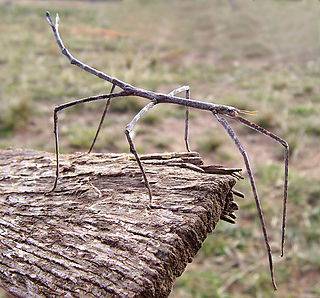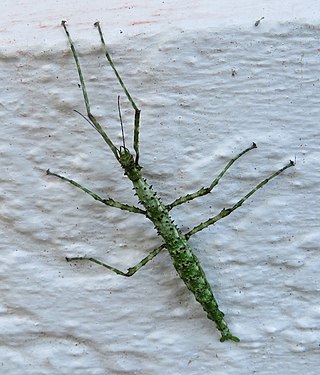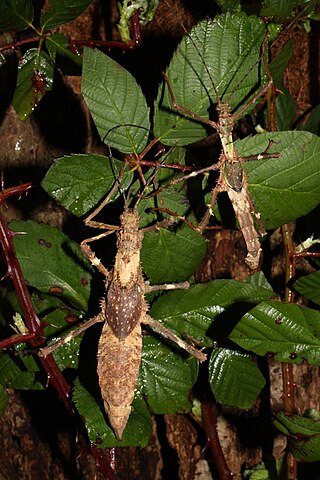
The Phasmatodea are an order of insects whose members are variously known as stick insects, stick-bugs, walkingsticks, stick animals, or bug sticks. They are also occasionally referred to as Devil's darning needles, although this name is shared by both dragonflies and crane flies. They can be generally referred to as phasmatodeans, phasmids, or ghost insects, with phasmids in the family Phylliidae called leaf insects, leaf-bugs, walking leaves, or bug leaves. The group's name is derived from the Ancient Greek φάσμα phasma, meaning an apparition or phantom, referring to their resemblance to vegetation while in fact being animals. Their natural camouflage makes them difficult for predators to detect; still, many species have one of several secondary lines of defense in the form of startle displays, spines or toxic secretions. Stick insects from the genera Phryganistria, Ctenomorpha, and Phobaeticus include the world's longest insects.

Phobaeticus serratipes is a species of stick insect that at one time was the longest known insect, with one female specimen recorded as being 55.5 cm (21.9 in) in total length. This measurement includes the legs fully extended front and rear, and the actual length of the body alone is considerably shorter. This insect is endemic to Peninsular Malaysia, Singapore and Sumatra. It is a popular species among those who raise insects.

The Phasmatidae are a family of the stick insects. They belong to the superfamily Anareolatae of suborder Verophasmatodea.

Megacrania batesii, commonly known as the peppermint stick insect, is an unusual species of stick insect found in northeastern Australia, the Bismarck Archipelago, the Solomon Islands, New Guinea, and possibly as far north as the Philippines. It is notable for its aposematic coloration, as well as its robust chemical defense mechanism. Its common name refers to the irritating fluid — with an odor resembling peppermint — that it sprays as a defensive action from a pair of glands located at its prothorax when threatened, as well as the cylindrical, twig-like shape of its body. A member of the subfamily Megacraniinae, it was first described by English naturalist and explorer Henry Walter Bates in 1865.

Phobaeticus is a genus of Asian stick insects comprising over 25 species. The genus includes some of the world's longest insects.

Eurycnema goliath, commonly known as the goliath stick insect, or the regal stick insect, is a large species of stick insect in the family Phasmatidae, endemic to Australia and considered one of the largest species of stick insects in the country. The species has the Phasmid Study Group number PSG14.
Phobaeticus chani, the Chan's megastick, is a species of stick insect in the tribe Pharnaciini, native to the southeast Asian island of Borneo. It is one of the longest insects in the world and was once considered the record-holder. One specimen held in the Natural History Museum in London measures 56.7 cm (22.3 in). This measurement is, however, with the front legs fully extended. The body alone still measures an impressive 35.7 cm (14.1 in).

Ctenomorpha marginipennis, the margin-winged stick insect, is a species of stick insect endemic to southern Australia. The species was first described by George Robert Gray in 1833.

Pulchriphyllium bioculatum, Gray's leaf insect, is a leaf insect of the family Phylliidae native to tropical Asia as well as Madagascar, Mauritius and the Seychelles. It was first described by George Robert Gray in 1832 and was the first phasmid he discovered. Leaf insects have extremely flattened, irregularly shaped bodies, wings, and legs. They are usually about 5–10 cm long. They are called leaf insects because their large, leathery forewings have veins that look similar to the veins on the particular type of leaves they inhabit. Its scientific name bioculatum means "two-eyed" and refers to the two dots located on the abdomen just in this species.

Acanthoxyla prasina, the prickly stick insect, is a stick insect in the order Phasmatodea and the family Phasmatidae. It is native throughout New Zealand, although it is less frequently reported than "common" stick insect species. It has been introduced to Britain, predominantly Cornwall and Devon, and to the south-west region of the Republic of Ireland. It has a thorny skin, which is used as camouflage.

Eurycantha horrida, the thorny devil walking stick, is a species belonging to the stick insects and to the family Phasmatidae.

Phryganistria tamdaoensis is a species of stick insect belonging to the family of giant sticks. It was described in 2014 based on specimens from the Tam Đảo National Park in Vietnam, hence, the specific name tamdaoensis. It was described by Joachim Bresseel and Jérôme Constant, biologists of the Royal Belgian Institute of Natural Sciences (RBINS). In the same paper they also reported the discovery of another new subspecies, Phryganistria heusii yentuensis, which – measuring 32 cm long – is the second biggest insect known to date. In contrast, P. tamdaoensis, measuring only 23 cm long, is one of the smallest species under giant sticks.
Abrosoma nebulosum is a species of phasmid or stick insect of the genus Abrosoma. It is found in Sri Lanka.

Phasmotaenia lanyuhensis is a species of stick insect, order Phasmatodea. It is endemic to Taiwan. It is often included in the family Phasmatidae, although sometimes excluded from it when the family is strictly delimited. It derives its specific name from its type locality, Lanyuh Island, commonly known as Orchid Island.

Datamini is the only tribe within the subfamily of the Dataminae from the order of the Phasmatodea. The representatives of this subfamily are on average not as large as those of the other two subfamilies belonging to the family of Heteropterygidae.

Heteropterygini is the only tribe within the subfamily of the Heteropteryginae. With 19 representatives described, this subfamily includes the fewest species of the three subfamilies, but includes the largest and most striking species of the family.

Haaniella is a genus of the Phasmatodea family Heteropterygidae from Southeast Asia.

Theramenes is a genus of medium-sized stick insects in the tribe Obrimini, which is native to the Philippines and to the Indonesian Talaud Islands.
Phobaeticus annamallayanus is a species of stick insect found in forests in Tamil Nadu and Kerala. Its type location is in the forests of the Annamallay hills.














